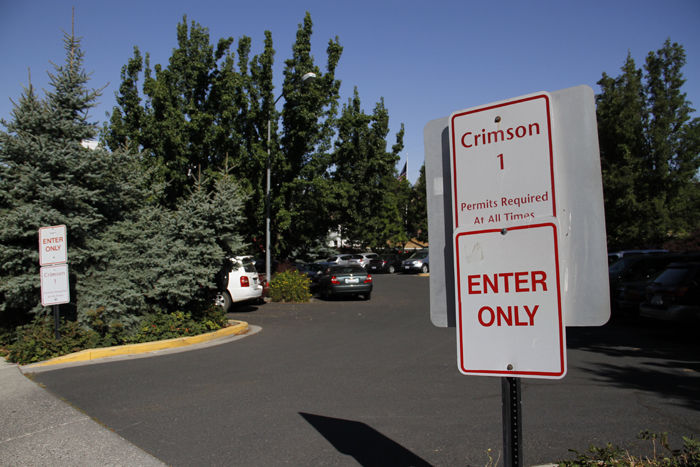Parking pandemonium
August 31, 2016
Imagine this nightmare sequence that begins at 7:45 a.m.
You live in Apartment Land, slept in late and now must make an 8 a.m. exam. Thankfully, you have an automobile. You quickly throw sweatpants and a shirt on, grab your backpack and keys and rush into the driver’s seat. Speed limits become mere suggestions as you bolt into the center of campus.
Then the shocking realization hits — on-campus parking is first-come first-serve. Without a transportation services office, WSU parking is a free-for-all. Early birds, faculty and staff have claimed every space in sight. Worse, the yellow paint of the lines have faded to the point that the pot-holed spots are not even discernible.
As 8:05 and 8:10 tick by, you still have not found an empty spot. By 8:20 you finally find a space barely large enough. You squirm out of your door so as not to hit the vehicle next to yours and sprint to the exam.
Luckily, this is not our reality: WSU Transportation Services exists to lend order to the chaos, avoiding the free-rider problem – or free-driver problem in this case – that would otherwise plague on-campus parking.
“We are pretty much a self-supporting auxiliary (of the university),” director of Transportation Services John Shaheen said. “We get no capital money from the state.”
Shaheen said he estimates his department runs on an annual budget of $4.5 million with revenues from three sources: annual, monthly and daily parking permits; short term meters and garages; and parking fines.
“Parking fines form a surprisingly small part of this,” Shaheen said. He estimated about $550,000, or about 12 percent of their annual budget comes from fines.
In terms of the business model, WSU is better off being self-sustaining.
“Imagine where parking would be on the state’s list of priorities,” Shaheen said. “At the bottom.”
For those decrying the rates, they have not changed in a year. An April 18 report from WSU News said there will be no increase in parking permit rates for the 2017 fiscal year, which began July 1 and will end June 30, 2017.
Now, keeping the rates down at face value is always attractive to Cougar motorists. However, this comes at a cost to infrastructural improvements.
Shaheen estimated that only $700,000 remains from annual revenues for capital improvement, which he said was sufficient for maintaining the status quo.
With construction gobbling up many street-side parking areas, the status quo might not be enough.
Unfortunately, neither are the revenues. In the case of parking space supply, the constraint of physical space limits possible increases to the stock.
To increase parking space at the center of campus, Shaheen said additional revenue for construction of underground parking would be necessary.
This by extension would require parking rate increases beyond the rate of inflation.
None of these stipulations deny that additional parking infrastructure will be needed. The newest underground parking is attached to the Smith Center for Undergraduate Education and was built in 2001.
Shaheen and Transportation Services realize this insufficiency.
“We have localized shortages, and that’s what people want to know: how we are going to address this,” he said.
To that end, he hopes a proposal will be introduced this semester concerning these issues that will be decided on by the beginning of next semester.
In the meantime, Transportation Services exhorts the merits of alternate forms of transport.
“We want to build on existing alternative options,” Shaheen said.
These options include Pullman Transit buses, biking, carpooling, vanpooling and walking. The hope is to even create a WSU-University of Idaho vanpool to replace the missing Moscow-Pullman bus.
Admittedly, infrastructure is rarely perfect. Parking space is in limited supply by pure spatial necessity.
To create order from what would otherwise be parking pandemonium, Transportation Services creates a willingness to pay threshold.
Unpopular though it may be, it is necessary: Not every Coug can park on campus.
The long-term solution is to advocate for better alternative options.
Pullman Transit has drastically increased its service options from last year, increasing weekday services by five routes to better accommodate Apartment Land residents. The North and South Routes now run until midnight, even on Saturdays.
An often overlooked option is Zipcar, a WSU-contracted service with a $15 membership fee and flat hourly or daily rental fares that include gas and insurance.
Shaheen said there are plans to expand the Zipcar fleet, especially since WSU does not pay for it.
So the next time you grumble about the parking permit prices, remember: The chaotic alternative is unacceptable. In the case of on-campus parking and transport access, we get what we pay for.
Besides, walking and biking are better for you anyway.
Tyler Laferriere is a graduate student pursuing his master’s in economics from Phoenix, Arizona. He can be contacted at 335-2290 or by [email protected]. The opinions expressed in this column are not necessarily those of the staff of The Daily Evergreen or those of The Office of Student Media.




















